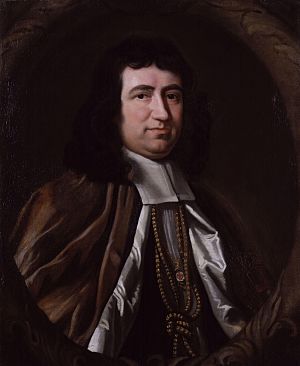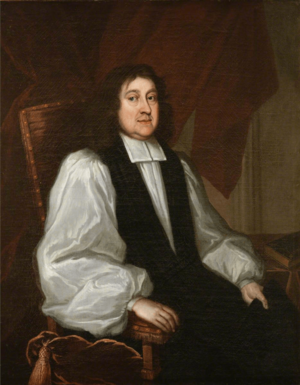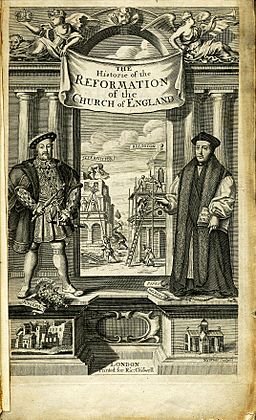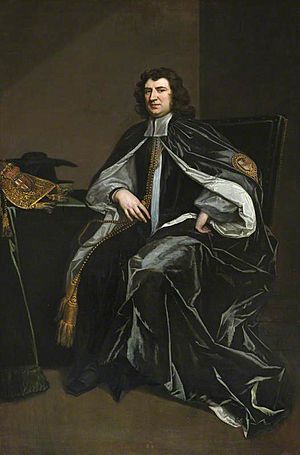Gilbert Burnet facts for kids
Quick facts for kids The Right Reverend Gilbert Burnet |
|
|---|---|
| Bishop of Salisbury | |

Portrait of Gilbert Burnet after John Riley, circa 1689–1691
|
|
| Church | Scottish Episcopal Church / Church of England |
| Predecessor | Seth Ward |
| Successor | William Talbot |
| Personal details | |
| Born | 19 September 1643 Edinburgh, Scotland |
| Died | 17 March 1715 (aged 71) St John's Court, Clerkenwell, London, England |
| Education | University of Aberdeen |
Gilbert Burnet (September 18, 1643 – March 17, 1715) was an important Scottish thinker, historian, and a bishop in the Church of England. He was very smart and could speak many languages, including Dutch, French, Latin, Greek, and Hebrew. People respected Burnet as a church leader, a speaker, a scholar, and a writer. He was a strong supporter of the Whig political party. He was also one of the few close friends whom King William III trusted.
Contents
Early Life and Studies (1643–1674)
Gilbert Burnet was born in Edinburgh, Scotland, in 1643. His father, Robert Burnet, was a lawyer and judge who supported the King. Gilbert's mother was Rachel Johnston. His father taught him at home until he went to the University of Aberdeen. He earned a Master of Arts degree in Philosophy at just thirteen years old.
After studying law for a short time, he decided to study theology instead. He traveled for several years, visiting places like Oxford, Cambridge, London, the Netherlands, and France. In Amsterdam, he learned Hebrew from a Rabbi. In 1665, he returned to Scotland and became a minister in the Church of Scotland. In 1664, he was also chosen as a Fellow of the Royal Society.
Burnet began his work as a minister in a small church in East Saltoun, Scotland. He served this community for four years. In 1669, he was offered a teaching position at the University of Glasgow. He first said no because his church wanted him to stay. But when the Bishop of Edinburgh asked him to accept, he did. He was later offered a bishop position in Scotland but turned it down.
Around 1672, he secretly married Lady Margaret Kennedy. She was the daughter of the Earl of Cassilis and was much older than him. They kept their marriage a secret for a while because of their different ages and backgrounds. Burnet was not interested in her money. He signed an agreement giving up any claim to her wealth. He said they had been good friends for years and felt they should marry. Their marriage seemed happy, but they did not have children, which Burnet wished for. He later had many children with his other wives.
Life in London (1674–1685)
In 1674, Burnet moved to London due to the unstable political situation. There, he supported the Whig party because of his political and religious beliefs. He was very active in the debates of the time. He tried to help the Episcopal Church and Presbyterianism find common ground.
King Charles II liked Burnet, and he received several favors from the King. Burnet described Charles as a smart but cynical person. The King believed that people were mostly driven by their own interests. Burnet understood this view, given the King's difficult experiences during the English Civil War. He also noted Charles's amazing self-control. The King could easily switch from serious work to fun activities.
The Popish Plot
During the time of the Popish Plot, Queen Catherine was accused of planning to murder her husband, King Charles II. The King told Burnet that he felt guilty about how he had treated the Queen. He said she was "incapable of doing a wicked thing" and he would not abandon her. Burnet, in turn, told the King that the Earl of Shaftesbury was not involved in the charges against the Queen. Shaftesbury was too smart to make such a big political mistake.
Burnet himself was not fully convinced about the Plot. He believed there might have been some Catholic conspiracy. However, he doubted the truthfulness of the informers, especially Titus Oates. He worried that innocent people might be wrongly accused. He spoke highly of Oliver Plunkett, a Catholic archbishop, saying he was a good and innocent man.
History of the Reformation
In the mid-1670s, a French book appeared that criticized the English Reformation. Friends asked Burnet to write a response. So, in 1679, he published the first volume of his book, The History of the Reformation of the Church of England. This first part covered the time of King Henry VIII. The second volume, published in 1681, covered the reign of Elizabeth. The third volume, published in 1715, added corrections and more information.
This book greatly improved his reputation as a writer. The Parliament of England thanked Burnet for his first volume. In 1680, the University of Oxford gave him a Doctor of Divinity degree. For over 100 years, this book was the main source of information on the topic.
Years in Exile (1685–1688)
When the Catholic King James II became king in 1685, Burnet asked to travel abroad. King James happily agreed. Burnet left England in May and traveled through Switzerland and Italy. He was offered a meeting with Pope Innocent XI but declined. After more travels, he arrived in Utrecht, Netherlands, in May 1686.
William, Prince of Orange, and his wife Princess Mary invited Burnet to live in The Hague. This made King James angry. He formally removed Burnet from his court. However, Burnet stayed in touch with William and Mary. Burnet advised them that William would need more than just his marriage to Mary to become king if she became Queen.
In 1687, King James wanted William and Mary to support removing the Test Act. This law placed restrictions on Catholics. Burnet wrote against removing the Act. William and Mary followed Burnet's advice and did not support the repeal. Burnet also upset King James by getting engaged to Mary Scott, a wealthy heiress. His first wife, Lady Margaret, had died in 1685. King James then accused Burnet of high treason in Scotland. He claimed Burnet was in contact with people convicted of treason. To protect Burnet, the States General of the Netherlands made him a citizen. They refused King James's request to send Burnet back to England.
Burnet and Mary Scott married, and they had a happy marriage. Burnet, who thought he would never have children, soon became a father to a growing family. He also helped translate an important letter from William's chief minister, Gaspar Fagel. This letter suggested a policy that would help non-conformists but keep restrictions on Catholics.
Burnet was not told about William's plan to invade England until July 1688. He was known for not being able to keep secrets. But his help was needed to translate William's Declaration, which would be given out in England after William landed. When William's fleet sailed for England in October 1688, Burnet became William's chaplain.
The Glorious Revolution
William landed in Torbay on November 5. When Burnet came ashore, he quickly went to William and asked what he planned to do next. William did not like non-military people interfering in military matters. But he was in a good mood and jokingly replied, "Well, Doctor, what do you think of predestination now?"
Burnet was chosen to preach the sermon at William and Mary's coronation on April 11, 1689.
In 1698, he was appointed tutor to Prince William, Duke of Gloucester, Queen Anne's only surviving child. Burnet tried to refuse the job. He knew that Anne disliked anyone favored by King William. But the King insisted, even though Burnet was mourning his second wife, Mary Scott, who had died recently. Most of Anne's household and Anne herself did not welcome the appointment. But Burnet cheerfully remembered, "I lived with them well enough." He was known for not getting easily offended. After Mary's death, Burnet married Elizabeth Berkeley in 1700. She had been Mary's best friend. Mary herself had told Burnet that if she died, she wished him to marry Elizabeth.
Bishop of Salisbury
On Easter 1689, Burnet became the Bishop of Salisbury. Three days later, he was made Chancellor of the Order of the Garter. As bishop, he was known for his open-minded views and his strong dedication to his duties.
Under Queen Anne
Burnet was present when King William died. He rushed to be the first to tell the new Queen Anne the news. He knelt before her, but people "generally laughed at" him. He was not in Queen Anne's favor during her reign. She generally disliked anyone King William had liked. She also seemed to think Burnet was a bit silly, though sometimes entertaining. Still, like the kings before her, she sometimes confided in him. In 1713, he warned her about a possible invasion by the Old Pretender. The Queen was not impressed. She noted that Burnet had made a similar prediction the year before, which had not come true.
He was asked to write responses to works by Socinian writers. These writers had different religious views. However, Burnet was somewhat open to non-conformist ideas.
Last Years and Death
In 1714, as Queen Anne was close to death, Burnet worried about what would happen if her Catholic half-brother became king. He feared bad consequences for Protestants. But most people did not take his predictions seriously. One person wrote to him, "Be easy my Lord... I am sure you need not die a martyr for your faith." In the end, the throne passed peacefully to the Protestant House of Hanover in August 1714. This was seven months before Burnet's own death.
Burnet died of a fever on March 17, 1715, after being ill for only three days. He was calm, cheerful, and ready for death. His will was said to have pleased everyone. He left one-third of his money to his oldest son. The rest was divided among his other four children.
History of His Own Time
Burnet started writing Bishop Burnet's History of His Own Time in 1683. This book covered the English Civil War up to 1713. The first part was published in 1724, and the second in 1734. This work describes the history of the Civil Wars and gives a detailed account of the period that followed. Even though it shows some of his own opinions, it tries to be accurate and fair. It is valuable because Burnet was an eyewitness to many events. The writing style is lively and vivid.
A book called A Supplement to Burnet's History of my Own Time was published in 1902. It added more information about Burnet's life.
Religious Views
After 1664, Burnet became friends with Dutch Arminians, who had more open-minded religious views. He changed his own beliefs to be more in line with Arminianism. He was known for his broad interpretation of religious articles.
One of his other works is Lives, characters, and an address to posterity.
Family Life

Gilbert Burnet married three times. His first wife, around 1672, was Lady Margaret Kennedy. She was known for her beauty and strong character and was much older than him. Their marriage was kept secret for a while. Gilbert gave up any claim to her money. She reportedly lost her memory before she died in 1685.
His second wife, whom he married in 1687, was Mary Scott (1660–1698). She was a wealthy Dutch heiress with Scottish roots. Even though she brought him money, their marriage was seen as a loving one. Mary, who had a lot of freedom due to her wealth, always said she would only marry someone she truly cared for. She died of smallpox in 1698 while visiting Rotterdam.
In 1700, he married his third wife, Elizabeth Berkeley (née Blake). She was a widow and a religious writer. This marriage largely happened because Burnet's second wife, Mary, had suggested it. Mary, fearing she might die from smallpox in Rotterdam, told Burnet that if she passed away, she wished him to marry Elizabeth, who was a close friend.
All of Burnet's children who survived were from his marriage to Mary Scott. Elizabeth had two daughters who died young.
His three surviving sons with Mary were:
- William Burnet, who became a governor in America (New Jersey, Massachusetts, and New Hampshire).
- Gilbert Burnet, a writer of pamphlets.
- Thomas Burnet, who became a judge.
He and Mary also had twin daughters:
- Mary, who married David Mitchell.
- Elizabeth, who married Richard West, a well-known lawyer. Their son, Richard West the younger, became a poet.
Burnet was a loving father, and all his children were very fond of him. Even his son Thomas, who had a wild youth, truly grieved for "the best of fathers."

Personality
Some historians believe that Gilbert Burnet's great talents were not always fully recognized. This might be because he sometimes had a playful or silly side to him.





